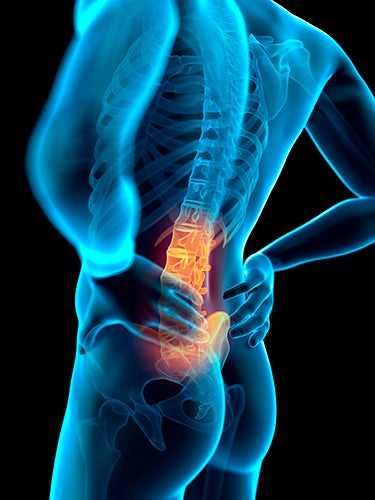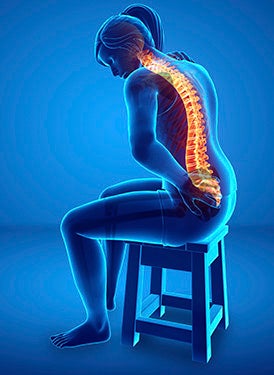Compression Fractures of the Spine
 The Basics
The Basics
The moving parts of the spine are interconnected and dependent upon each other for range of motion and mobility. Between the bones (vertebrae) is a cushion-like material called an intervertebral disc. The primary function of the disc is to act as a shock absorber against injury and provide support during stress or impact.
When the spinal column is exposed to trauma, the force can create a fracture or break within the vertebra. The severity of a fracture can vary depending on the integrity of surrounding tissues, particularly the discs.
Location
Compression fractures can occur anywhere within the spine but are most common in the thoracic and lumbar regions. Fractures will often present in the front of the vertebrae creating a wedge-shaped space between bones.
Symptoms
Fractures will usually cause acute pain if due to injury or chronic pain if caused by age-related bone loss (osteoporosis)
Acute
- Sudden Onset
- Stabbing/Shooting
- Numbness/Tingling
- Worse with Movement
- Better with Rest
Chronic
 Progressive/Long-Term
Progressive/Long-Term- Dull Achiness
- Changes in Height
- Changes in Posture
- Reduced Range of Motion
Causes
Most commonly, compression fractures are due to an age-related condition of the bones known as osteoporosis. This slow deterioration causes vertebrae to become brittle and weak. Over time, this increases the risk for fractures or breaks.
Falls or accidents can also cause traumatic fractures. During severe impact, the shock-absorbing discs between vertebrae cannot sustain excessive force and become crushed. Without a protective barrier in place, the vertebrae can collide or overlap, resulting in a traumatic fracture.
Treatment
Treatment will vary based on the location and severity of injury but most fractures can be treated with a brace to stabilize the spine. Gradual increased activity and physical therapy will often fully resolve an injury within 6 to 12 weeks.
Surgical intervention is only required if the fracture is unstable or causes damage to surrounding tissue.
